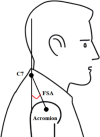Changes in shoulder function and muscle strength following rehabilitation exercise program in male patients with forward shoulder posture undergoing rotator cuff repair
- PMID: 39358776
- PMCID: PMC11448409
- DOI: 10.1186/s12891-024-07905-0
Changes in shoulder function and muscle strength following rehabilitation exercise program in male patients with forward shoulder posture undergoing rotator cuff repair
Abstract
Background: Abnormal posture is known to affect the efficacy of exercise therapy for musculoskeletal diseases. However, no studies to date have examined the effect of exercise programs should take into account the posture of the upper body in patients with rotator cuff disease. This study aimed to assess how rotator cuff and corrective exercises impact shoulder function and muscle strength post-arthroscopic rotator cuff repair surgery, providing tailored rehabilitation programs for patients with forward posture.
Methods: Ninety male patients who underwent arthroscopic rotator cuff repair participated in this study. The patients were randomly divided into three groups corrective exercise group (CEG, n = 29), rotator cuff exercise group (REG, n = 27), and control group (CG, n = 28). Each group was instructed to apply different exercise programs to correct posture and enhance rotator cuff strength. All patients were checked by the American Shoulder and Elbow Surgeons (ASES) score, Constant score and muscle strength, and range of motion preoperatively and postoperatively at 6 months and 1 year.
Results: ASES shoulder function scores showed significant difference between the three groups (p = 0.002, F = 7.03), indicating that the corrective exercise program was more beneficial than rotator cuff exercises (p = 0.009, F = 3.78). A significant intergroup difference in mean Constant score was also noted (p = 0.025, F = 3.86), while a statistically significant interaction between time and group was observed (p = 0.032, F = 2.96).
Conclusions: These results suggested that a corrective exercise program can improve shoulder muscle strength and function after rotator cuff repair in male patients with a forward shoulder posture.
Keywords: Corrective exercise; Forward shoulder posture; Rehabilitation; Rotator cuff; Rotator cuff exercise.
© 2024. The Author(s).
Conflict of interest statement
The authors declare no competing interests.
Figures
References
-
- Sergienko S, Kalichman L. Myofascial origin of shoulder pain: a literature review. J Bodyw Mov Ther. 2015;19(1):91–101. - PubMed
-
- Conti M, Garofalo R, Delle Rose G, Massazza G, Vinci E, Randelli M, et al. Post-operative rehabilitation after surgical repair of the rotator cuff. Chir Organi Mov. 2009;93(Suppl 1):S55–63. - PubMed
-
- Keener JD. Revision rotator cuff repair. Clin Sports Med. 2012;31(4):713–25. - PubMed
-
- Mazuquin BF, Wright AC, Russell S, Monga P, Selfe J, Richards J. Effectiveness of early compared with conservative rehabilitation for patients having rotator cuff repair surgery: an overview of systematic reviews. Br J Sports Med. 2018;52(2):111–21. - PubMed
Publication types
MeSH terms
LinkOut - more resources
Full Text Sources
Medical






